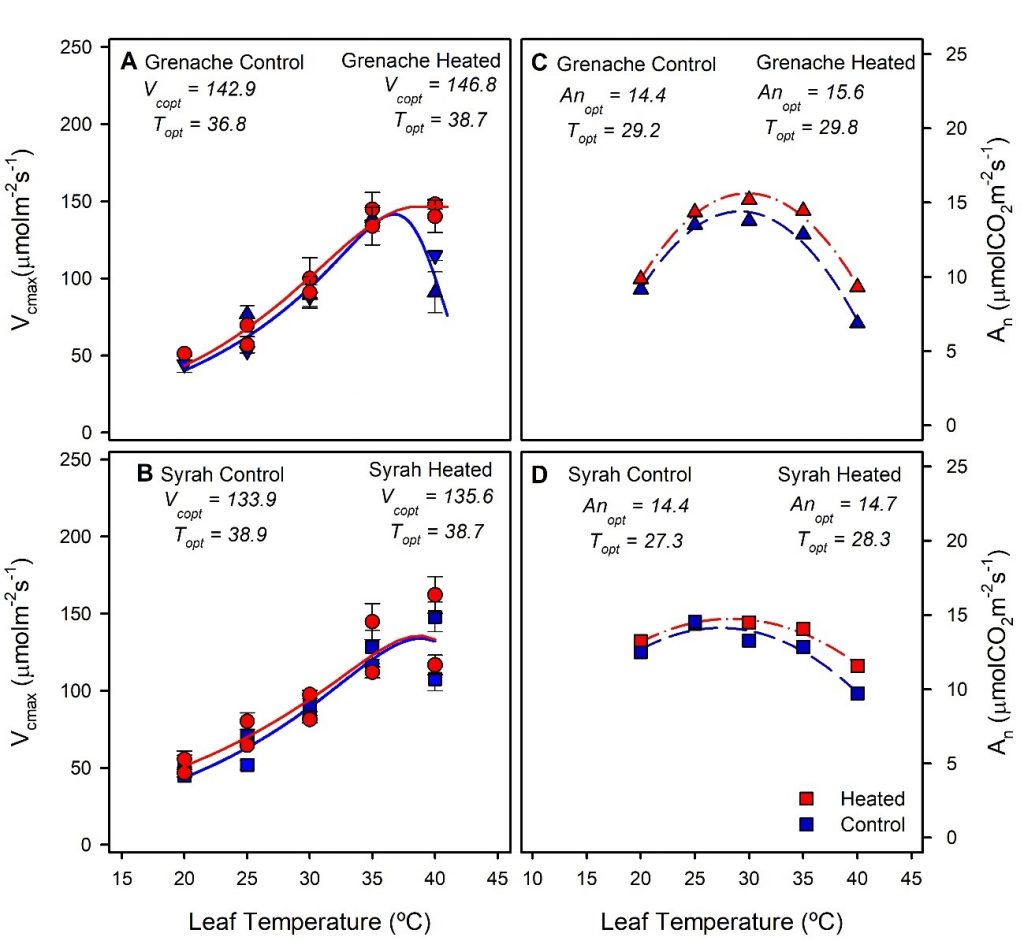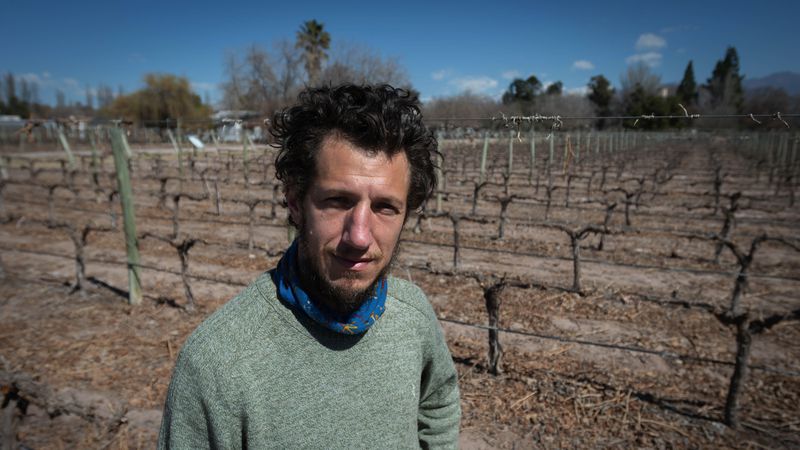By Agustina E. Gallo, Jorge E. Perez Peña, Jorge A. Prieto
For the complete study, see Gallo A.E., Perez Peña J.E., Prieto J.A. (2020) Mechanisms underlying photosynthetic acclimation to high temperature are different between Vitis vinifera cv. Syrah and Grenache. Functional Plant Biology. https://doi.org/10.1071/FP20212.
Climate change is challenging many cultivated regions and natural ecosystems, as well as viticulture production worldwide (Flexas et al. 2010). Many viticultural areas are facing water scarcity, warming and heat waves, including the main grape-growing regions in Argentina (Cabré et al. 2016). One of the most sensitive physiological processes to temperature is photosynthesis. Understanding the mechanisms explaining photosynthetic response and acclimation to higher temperatures is crucial for agriculture (Yamori et al. 2014). The photosynthesis acclimation to temperature was defined as the environmentally induced changes in photosynthetic characteristics that result in improved performance under a warmer regime (Berry and Björkman 1980). As growth temperature (Tgrowth) increases, the most common reported response is a shift in the thermal optimum for photosynthesis (Topt), which leads to an increase in the photosynthetic efficiency at the new growth temperature (Yamori et al. 2014). Alternatively, some plants exhibit a homeostatic maximum net assimilation (An) when growth temperature increases that do not increase C assimilation at the new growth temperature (Way and Yamori 2014), indicating a wide thermal optimum range for photosynthesis. However, there is a discrepancy between studies about the extent of photosynthetic acclimation which appears to be species and even cultivar dependent (Yamori et al. 2014).
Several mechanisms explain the thermal acclimation of photosynthesis to growth temperature (Way and Yamori 2014). In C3 species such as grapevine, the temperature dependency of photosynthesis is set by changes in the RuBP carboxylation rate (or RUBISCO activity) and the electron transport photochemistry for the regeneration of RuBP in the Calvin cycle (Farquhar et al. 1980; Medlyn et al. 2002). These two processes can be assessed from the maximum RUBISCO carboxylation rate (Vcmax) and the maximum electron transport rate (Jmax) respectively, which determine the leaf photosynthetic capacity (Farquhar et al. 1980). The temperature dependency of Vcmax and Jmax shows variability at the inter-specific (Medlyn et al. 2002) and intra-specific levels, including some grapevine genotypes (Greer 2018).
The main objective of this study was to evaluate (i) the mechanisms underlying the long-term acclimation of photosynthesis to elevated temperature and (ii) to determine whether these responses are similar among Syrah and Grenache, two varieties with different behavior in response to environmental factors (Schultz 2003). In our experiment, we imposed an increase in growth temperature (Tgrowth) between 1.5 and 3.6 °C in field-grown plants during the whole season. We compared the thermal acclimation in terms of optimum temperature for photosynthesis (Topt), the photosynthetic rate at Topt (Aopt) and the temperature dependencies of photosynthetic capacity (Vcmax, Jmax), at each growing temperature during two consecutive seasons.
A warming experiment with well-irrigated Grenache and Syrah field-grown plants was conducted during 2016/17 and 2017/18 growing seasons at INTA, Experimental Station Mendoza, Argentina. We compared plants exposed to ambient temperature (control) with plants exposed to increased air temperature (heated). Heating was applied from budburst to harvest. Mean air temperature was increased between 1.5 and 3.6°C by an open top heating system (Figure 1) installed under the vines along the row (Sadras and Soar 2009). Photosynthetic acclimation was assessed through the response of net assimilation (An), Rubisco carboxylation rate (Vcmax) and electron transport rate (Jmax) at leaf temperatures from 20 to 40°C. We calculated the optimum temperature for photosynthesis (Topt) for both varieties and temperature regimes.

Mean air temperature increased in heated plants between 1.5 and 2.1°C during leaf development and between 1.5 and 3.6°C during early summer, for the first and second season respectively. The increase in air temperature achieved in our experiment is consistent with the expected warming in many of the main viticulture areas of Argentine for this century and many other regions in the world (Cabré et al. 2016).
Grenache and Syrah presented different mechanisms of photosynthesis acclimation to increases in growth temperature. Only Grenache increased Aopt leading to an increase in C assimilation in the higher Tgrowth. Accordingly, from the response curves to leaf temperature, Grenache heated plants maintained Vcmax and Jmax rates at 35°C and 40°C whereas non-heated plants presented a steep decrease at those temperatures (Figure 2). By contrast, Syrah presented a homeostatic acclimation, with no changes in Aopt nor photosynthetic capacity (Vcmax and Jmax) or their temperature dependencies, confirming the adaptation of this variety to different environmental conditions (Sadras and Soar 2009). Although both varieties showed an increase in Topt for An as growth temperature increased, Syrah increase in Topt was higher (Figure 2). Higher temperatures during the second season did not increase Topt more than the first season, because leaf temperatures were already high and photosynthetic acclimation was limited (Vico et al. 2019).

Conclusions
We found different mechanisms in the photosynthetic acclimation to growth temperature in field-grown Grenache and Syrah vines under non-limiting water conditions. Under warmer conditions, photosynthesis in Grenache was enhanced through an increase in photosynthetic capacity (i.e. Vcmax, Jmax), leading to an increase in the optimum temperature for An, and improving C assimilation at the new growth temperature. Syrah maintained photosynthetic capacity, with no changes in Vcmax nor Jmax, leading to a homeostatic response, that is, an adjustment of net photosynthesis to the new growth temperature, without a gain in C assimilation. For both varieties, the increase in Topt under heating was lower the second season when differences in air temperature with control were greater. This indicate that the extent of photosynthetic acclimation to warmer temperatures may be lower when plants are already exposed to temperatures near their optimum, as in our experiment. Our study showed that an increase in air temperature between 1.5 and 3.6°C, as expected by some climate change scenarios, would not affect directly C assimilation of these varieties under well-watered conditions.

Agustina Eugenia Gallo 
Jorge E. Perez Peña 
Jorge A. Prieto
Agustina Eugenia Gallo
Since 2016 I have been a PhD student at Instituto Nacional de Tecnología Agropecuaria (Mendoza, Argentina) with CONICET fellowship. My research includes the effects of a sustained warming under a climate change context, in grapevine physiological traits such as photosynthetic and stomatal responses as well as grape physicochemical composition. I graduated with honors and obtained an Agricultural Engineer degree in 2015 from Universidad Nacional de Cuyo, Mendoza, Argentina. I worked in an internship in 2014, 2018 and 2019 at Institut National de la Recherche Agronomique, Montpellier, France. Thanks to all this work and other courses I’ve specialized in grapevine ecophysiology, experimental design and data analysis. I published my work in 1 paper as first author (FPB) and also in 5 scientific meetings, and collaborated in 1 paper (PNAS). I also worked as teaching assistant at university in 2010, 2016 and 2017. My native language is Spanish and I’m fluent in English and French.
Jorge E. Perez Peña
Agronomist degree from the College of Agronomy of the University of Buenos Aires, Argentina; Ms.Sc. in Irrigation and Drainage from University Nacional de Cuyo, Argentina, and Ph.D. from Washington State University, USA. Coordinator of Instituto Nacional de Tecnología Agropecuaria regional and national projects, projects of extra-budgetary funds (MINCYT), research coordinator and director of EEA Mendoza, responsible of agreements with national and foreign institutions, and coordinator of the INTA LABINTEX Laboratory in Montpellier, France. He has organized several national and international scientific and technological events on irrigation and viticulture. Advisor and co-advisor of master’s and doctorate theses of scholarship holders from both INTA, CONICET and the National Agency for Scientific and Technological Promotion. He is currently a researcher at the EEA Mendoza INTA in Plant Ecophysiology oriented to the cultivation of the vine on issues related to climate change, water (irrigation), light, temperature and its influence on the physiological processes related to yield and physicochemical composition of the grape.
Jorge Alejandro Prieto
I’m Agronomic Engineer from Facultad de Ciencias Agrarias, University Nacional de Cuyo (Mendoza, Argentina), I obtained the Ms Degree on Viticulture and Oenology and Biology Doctor both from Montpellier SupAgro (France). Currently, I’m a researcher in grapevine ecophysiology in aspects related to vineyard management, irrigation, genetic diversity, adaptation to climate change, and its impacts on the main physiological processes involved in berry and wine composition. I’m advisor and co-advisor of doctorate and master theses from INTA and CONICET students. I have coordinated national research projects at INTA and MINCYT and I’m the main professor of Viticulture at the Licenciatura of Enología in Maza University.
Contact: prieto.jorge@inta.gob.ar
Research Gate: https://www.researchgate.net/profile/Jorge_Prieto2
References
- Berry JA, Björkman O (1980) Photosynthetic Response and Adaptation to Temperature in Higher Plants. Annual Review of Plant Physiology 31, 491–543.
- Cabré MF, Quénol H, Nuñez M (2016) Regional climate change scenarios applied to viticultural zoning in Mendoza, Argentina. International Journal of Biometeorology 60, 1325–1340.
- Farquhar GD, von Caemmerer S, Berry JA (1980) A Biochemical Model of Photosynthetic CO2 Assimilation in Leaves of C3 Species. Planta 149, 78–90.
- Flexas J, Galmés J, Gallé A, Gulías J, Pou A, Ribas-Carbó M, Tomàs M, Medrano H (2010) Improving water use efficiency in grapevines: Potential physiological targets for biotechnological improvement. Australian Journal of Grape and Wine Research 16, 106–121.
- Greer DH (2018) The short-term temperature-dependency of CO2 photosynthetic responses of two Vitis vinifera cultivars grown in a hot climate. Environmental and Experimental Botany 147, 125–137.
- Medlyn BE, Dreyer E, Ellsworth D, Forstreuter M, Harley PC, Kirschbaum MUF, Le Roux X, Montpied P, Strassemeyer J, Walcroft A, Wang K, Loustau D (2002) Temperature response of parameters of a biochemically based model of photosynthesis. II. A review of experimental data. Plant, Cell and Environment 25, 1167–1179.
- Sadras VO, Soar CJ (2009) Shiraz vines maintain yield in response to a 2-4°C increase in maximum temperature using an open-top heating system at key phenostages. European Journal of Agronomy 31, 250–258.
- Schultz HR (2003) Differences in hydraulic architecture account for near- isohydric and anisohydric behaviour of two field-grown Vitis vinifera L. cultivars. Plant, Cell and Environment 26, 1393–1405.
- Vico G, Way DA, Hurry V, Manzoni S (2019) Can leaf net photosynthesis acclimate to rising and more variable temperatures? Plant, Cell and Environment 42, 1913–1928.
- Way DA, Yamori W (2014) Thermal acclimation of photosynthesis: On the importance of adjusting our definitions and accounting for thermal acclimation of respiration. Photosynthesis Research 119, 89–100.
- Yamori W, Hikosaka K, Way DA (2014) Temperature response of photosynthesis in C3, C4, and CAM plants: Temperature acclimation and temperature adaptation. Photosynthesis Research 119, 101–117.


[…] Science & Wine: Photosynthetic acclimation to high temperature in Syrah and Grenache […]